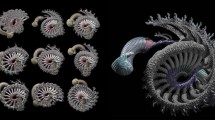Summary
This paper explores the application of ecosystem simulation to the production of works of generative electronic art. The aim is to demonstrate that virtual ecosystems are capable of producing outcomes that are rich, complex and interesting aesthetically. A number of artworks that employ virtual ecosystems are surveyed. The author argues that the most interesting works of generative art exhibit four basic properties: coherence and unity; multi-scaled temporal complexity; autonomous production of novelty; responsiveness to perturbation. The virtual ecosystem is assessed for its suitability as a medium for constructing generative art in light of these desirable properties. It is concluded that the ecosystem’s strengths lie in its exhibition of multi-scaled complexity and its autonomous production of novelty. Whilst an artist may manipulate a simulation to retain visual and sonic coherence, the software also possesses an implicit coherence inherent in its ability to self-organize. Under some circumstances it appears that the weakness of the virtual ecosystem as an artistic medium lies in its unpredictable response to perturbation. Consequently, the paper also explores virtual ecosystems’ susceptibility to external control and describes methods that have been employed to adjust the responsiveness of art works that employ them.
Access this chapter
Tax calculation will be finalised at checkout
Purchases are for personal use only
Preview
Unable to display preview. Download preview PDF.
Similar content being viewed by others
References
Whitelaw, M. (2004). Metacreation: Art and Artificial Life. The MIT Press
Innocent, T. (1999). The language of iconica. In Dorin, A., McCormack, J., eds.: First Iteration, CEMA. Melbourne
McCormack, J. (2001). Eden: An evolutionary sonic ecosystem. In Kelemen, J., Sosìk, P., eds.: Advances in Artificial Life, 6th European Conference. Lecture Notes in Computer Science. Springer, 133–142
Tansley, A.G. (1935). The use and abuse of vegetational concepts and terms. Ecology, 16(3): 284–307
Watson, A., Lovelock, J. (1983). Biological homeostasis of the global environment: The parable of daisyworld. Tellus B, 35: 284–289
Yaeger, L. (1994). Computational genetics, physiology, metabolism, neural systems, learning, vision, and behavior or PolyWorld: Life in a new context. In Langton, C.G., ed.: Proceedings of the Workshop on Artificial Life (ALIFE ’92). Sante Fe Institute Studies in the Sciences of Complexity. Reading, MA, USA. Addison-Wesley, 263–298
Ray, T.S. (1992). An approach to the synthesis of life. In Langton, C.G., Tayler, C., Farmer, J.D., Rasmussen, S., eds.: Artificial Life II. Addison-Wesley. Reading, MA, 371–408
Burkhart, R., Askenazi, M., Minar, N. (2006). Swarm documentation set. http://www.santafe.edu/projects/swarm/swarmdocs/set/set.html
Holland, J.H. (1998). Hidden Order: How Adaptation Builds Complexity (Helix Books). Addison Wesley Publishing Company
Epstein, J.M., Axtell, R.L. (1996). Growing Artificial Societies: Social Science from the Bottom Up. Brookings Institute
Adami, C., Brown, C.T. (1994). Evolutionary learning in the 2d artificial life system avida. In Brooks, R.A., Maes, P., eds.: Artificial Life IV: Proceedings of the Fourth International Workshop on the Synthesis and Simulation of Living Systems. Cambridge, MA, USA. MIT Press, 377–381
Deussen, O., Hanrahan, P., Lintermann, B., Mech, R., Pharr, M., Prusinkiewicz, P. (1998). Realistic modeling and rendering of plant ecosystems. In: SIGGRAPH ’98: Proceedings of the 25th Annual Conference on Computer Graphics and Interactive Techniques. New York, NY, USA. ACM Press, 275–286
Dorin, A. (2005). A co-evolutionary epidemiological model for artificial life and death. In Capcarrère, M.S., Freitas, A.A., Bentley, P.J., Johnson, C.G., Timmis, J., eds.: Advances in Artificial Life, 8th European Conference, ECAL. Lecture Notes in Computer Science. Springer, 775–784
Dahlstedt, P. (1999). Living melodies: Coevolution of sonic communication. In Dorin, A., McCormack, J., eds.: First Iteration, CEMA. Melbourne, 56–66
Berry, R., Rungsarityotin, W., Dorin, A., Dahlstedt, P., Haw, C. (2001). Unfinished symphonies – songs of 3.5 worlds. In: Workshop on Artificial Life Models for Musical Applications, Sixth European Conference on Artificial Life, Editoriale Bios. Prague, Czech Republic, 51–64
Sommerer, C., Mignonneau, L. (1999). VERBARIUM and LIFE SPACIES: Creating a visual language by transcoding text into form on the internet. In: VL ’99: Proceedings of the IEEE Symposium on Visual Languages. Washington, DC, USA. IEEE Computer Society, 90–95
Taylor, T. (2002). Creativity in evolution: individuals, interactions, and environments. In Bentley, P., Corne, D., eds.: Creative Evolutionary Systems. Morgan Kaufmann Publishers Inc.. San Francisco, CA, USA, 79–108
Dawkins, R. (1987). The Blind Watchmaker. W.W. Norton & Co. New York
Pargellis, A.N. (2000). Digital life behavior in the amoeba world. Artif. Life, 7(1): 63–75
Todd, S., Latham, W. (1992). Evolutionary Art and Computers. Academic Press. San Diego
Author information
Authors and Affiliations
Editor information
Editors and Affiliations
Rights and permissions
Copyright information
© 2008 Springer-Verlag Berlin Heidelberg
About this chapter
Cite this chapter
Dorin, A. (2008). A Survey of Virtual Ecosystems in Generative Electronic Art. In: Romero, J., Machado, P. (eds) The Art of Artificial Evolution. Natural Computing Series. Springer, Berlin, Heidelberg. https://doi.org/10.1007/978-3-540-72877-1_14
Download citation
DOI: https://doi.org/10.1007/978-3-540-72877-1_14
Publisher Name: Springer, Berlin, Heidelberg
Print ISBN: 978-3-540-72876-4
Online ISBN: 978-3-540-72877-1
eBook Packages: Computer ScienceComputer Science (R0)




